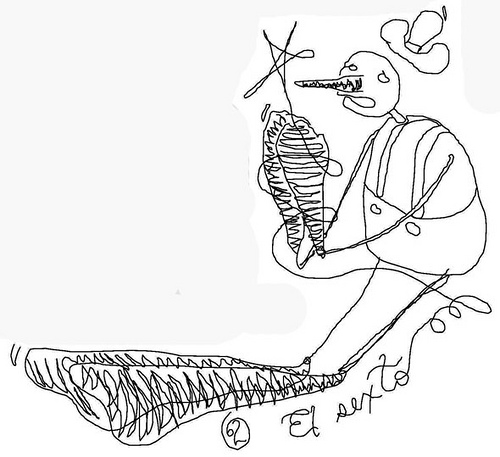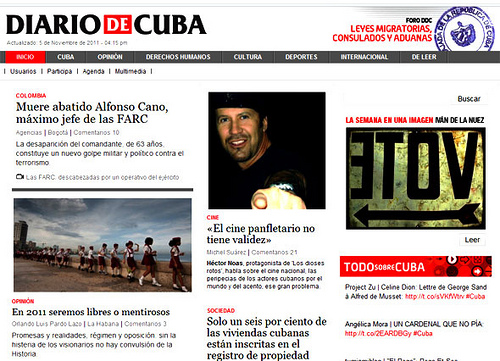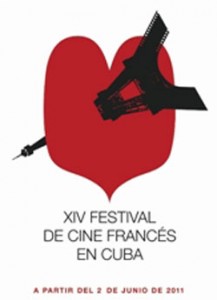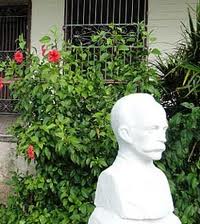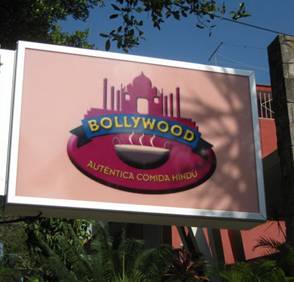Graffiti is not foreign to Cuba, why is your work causing so much attention in Cuba right now?
My work has an impact because I have repeated my process endlessly throughout the city, without respecting the partitioning of state space: walls, ruins, buses, signs, institutions. My work breaks the inertia of social discipline imposed upon by the powers that be: it is rebellious by nature. The El Sexto tag also makes a mockery of an official campaign for the release of five supermen (the so-called 5 Héroes prisioneros del Imperio [5 Hero Prisoners of the Empire] convicted of spying on the Cuban government in the US).
I read in the Havana Times that the government said: “Only the graffiti created after having received the approval of a State institution are valid and can be considered art, while the remaining ones lack cultural value and act only to deface public property.” Why not just get the approval of the state institution then, rather than go rogue? Why is doing it anyway so important to you?
I believe in an art that is true to self, free of cultural bureaucracy, without relying, much less bowing down to ask permission to do it, which ultimately, is the latest form of official censorship against freedom of expression, for independent artists. Graffiti was born spontaneous, authentic, very real, provocative and without anyone needing to legitimize it beyond the talent and spirituality of the author. In this case, me.
You’ve become quite infamous as a rebellious artist. How many times have you been arrested for your art? Can you remember the first time?
I’ve been arrested twice. The first time was a few months ago when I was in the middle of making a piece in front of a full government body of ministry officials and police personnel, who literally chased me through the corridors and atop the roofs of the neighborhood (the type of chase that makes for a bad Hollywood movie). I was released the same day with a fine of 60 pesos. The second time was a couple of weeks ago and it was more like a kidnapping, from capture to the sudden release, without providing the documentation required by Cuban law. In both cases, they handcuffed me to drive.
Were you really kidnapped?
I left my home in peace, without tagging, just two blocks from my home. It was a police car, but with a common Lada body, with four people in it, who did not identify themselves as cops and were dressed in civilian clothes (I was shown a card at the speed of light and I could not even read it while being reduced to the force of two strong men). I was taken to the police station at Zapata and C [streets] in the El Vedado neighborhood, which is very far from my residence in Arroyo Arenas. When my mother went to the Policía Nacional Revolucionaria [the national police department office] to find out what was happening, she was notified that my name was not in any authority record. My mother thought then that it was a mob vengeance against me (for money or for something otherwise marginal) and was terrified.
At the station, I removed all personal belongings, flash memory cards, cards, money, etc… I learned about a voluminous file against me, as thick as the Bible. One expert took nail samples from me to identify traces of paint (they had taken samples of my spray graffiti in the city earlier). They questioned my loyalty to the “Five anti-terrorism heroes who had fought so that my family did not fall” (I have a work that asks parodically, “Devuelvan mis 5 Euros” [“Return my 5 Euros”]. They also criticized the sentiment of my other graffiti and flyers, saying things like, “You strike out my things, I trash yours.”). The next day I was transferred to the 10 de Octubre area (even more distant from my home). Only then did my family have some information about me, but I could not see them until the third day, when I stopped eating in protest against such arbitrariness (they never even let me make a phone call or request the services of a lawyer). They questioned me about my most controversial friends (bloggers, musicians, photographers activists, civilians) and about my income outside the state. They emotionally blackmailed my mother and sister. They filmed and coerced me to sign several documents. On the fourth day, I was suddenly released, thanks in part to a media campaign by my friends and supporters on the Internet. When I got home, I discovered that they had confiscated my only laptop, flyers, sprays and my stencils, without the proper official documentation.
Do you see yourself as an activist or a social change agent? If yes, what are you hoping to change?
I hope to change the mono-system that exists in Cuba. On the streets, you’re only legally allowed to post graphic backgrounds that are political and over-saturated, in praise of the revolution and its leaders and ideological ridicule of the United States. The most criticized are inspired by Hip-Hop, Rock, Punk, among other manifestations underground (including, of course, rebellious graffiti), which all suffer daily censorship.
Can you describe the moment you decided to become an artist? And why graffiti?
I am an artist who has been painting since I was a child. I did not choose; the art chose me, I have no control of that phenomenon. Graffiti broke into my work in 2008, when I took one spray in my hand by chance, and by a sort of spell or “brujería cubana” [Cuban witchcraft], I could not release him while he had a drop of paint in him for free artistic expression on the canvas of my city. I love my art. I’m sick from it—very serious. And I do not want to heal or be cured.
Were you trained in the art world, how did you learn to build this skill?
From childhood, I have taken courses in Art History. I had a professional crafts workshop. But I still feel that I am an empirical and intuitive creator. The explosive power in Cuba called “bomba” (corazón) [heart] can not be taught in any school. It is the artistic skill acquired by painting promiscuously without stopping.
What was your favorite piece to create and why?
One of my first tags as El Sexto, no less, is stamped directly opposite the National Capitol, in a very central and symbolic place in Havana. Interestingly, this work has never been deleted (while those in other areas such as in El Vedado, have been).
You once wrote, “Yo solo necesito spray y este papelito…“…”I need my spray and my paper…” What else is in your tool kit? What can’t you work without?
Basically, stencils and sprays. I like to work with the best in the world, but in Cuba, it is impossible to be addicted to any brand name. More and more I fear the possibility of not having the material for my artistic expression, they are expensive and is freely convertible currency. Solidarity among colleagues is often low in Cuba. They are afraid to be “marked” as conflicting with cultural institutions to which they belong. Exiled Cuban artists almost always have the most work, while alternative projects in Cuba are suffocating. All international solidarity is welcome. But if one day I run out of paint, I’ll try to make myself absurd so as not mute. Although they will be of poor quality, and each piece will only last one day, I’ll find a way to do it, even if I have to do it with my own blood (several performance artists in Cuba have chosen this limit).
Tell me who El Sexto is, and how did you come up with your name? What does it stand for?
El Sexto is a kind of Robin Hood who left the “noise of the people”. El Sexto is any Cuban anonymous face who survives facing our social commitment, and so, El Sexto is everywhere and from everywhere, responding to the alienating media campaign (which takes more than a decade) of slogans for the release of the five US-convicted spies.
Do you think young people see your work differently from older generations of people? Any hope in bridging the gap?
I think not only young people capture the deeper meaning of my graffiti. That is the big concern for those in power (and who also understand the aesthetic indicative of my work very well). Graffiti’s barriers are at the neighborhood level. It’s a sympathy wave that adds up. It comes from a demagogic elitist thought, but is popular.
Graffiti, just like Hip-Hop, started in the states as a Brown and Black expressive culture that has since expanded to include others. What do you think graffiti means in Cuba? Is complexion a factor?
I don’t think so. There are no distinctions of race or folklore to appreciate my work at the moment. Cuba is a nation where everything is mixed, so there is no question of caste, except for the political position. Then, only, is there a distinction between ordinary people and top officials, among the dispossessed and the despots, among consumers and the censor.
Art is a huge movement in Cuba it seems, with so much talent coming from the island. Do you feel there is a strong community of support for your work?
The support provided is scarce, because unfortunately, solidarity prevails only among the already censored for power’s sake. It is still a distant day when the Cuban cultural field learns to respect artists for their works, not their political or personal taste, and so on. In this sense, there is much cultural apartheid in Cuba. We do not know the joys of a free reading of art.
Any plans to take your art overseas? And do you plan on signing with a gallery?
Zero plan. I’d love to, but I’m stuck on the island of permits. In any corner of this city at night, as I’m spreading the spray-virus of El Sexto, I open my phone +53-53869863 (often without credit, which is also in hard currency) for the best healers in the world. Call me as l put up murals on the brick wall galleries of Havana…!!!
Who are some of your early influences, and who are some of the artists that you like and respect dearly?
I think the original artists, who posted in caves now found in the bowels of the Earth, regardless of history. In contemporary times, I keep the duo Basquiat, Banksy.
Tell me about your upcoming exhibition, what is it called and what’s it all about? What are you trying to say? How many pieces, etc…?
My most recent exhibition is called No Son 5 [There aren’t 5]. It consists of the chronology of my flyers from the beginning—self-portraits on cardboard and canvas, spot graffiti on the walls of the alternative gallery, pictures of my own urban works and a performance projected on TV by some of the artists and bands censored by official media in Cuba today (in the exhibition, but in other enclosed public access), like Raudel of Eskuadrón Patriota, Luis Eligio and David of Omni Zona Franca, Porno Para Ricardo, Maykel Extremo, Ana Olema, Bárbaro El Urbano Vargas, Jimmy con Clase and several DJs. It was a great party and a free space to tell the disciplinary institutions that independent art in Cuba is alive and does not need them. It was twice the exposure at the opening (Saturday October 29, 2011). There was even a cumbersome operation of motorcycles and undercover agents on the blocks around, but that did not intervene because of the high number of guests and because we were tweeting live from our phones. Despite the Cuban Paleolithic Internet, the world follows us and we follow the world.
Are you afraid of the backlash you will receive from this exhibition?
I have more fear of not being who I am, not to manifest and share everything that I have inside. I believe that despite the pressures (I was interviewed by two security officials days before the opening, who led me to the official residence of the famous artist Kcho), the exhibition will be a milestone that marked a before and after in me and my work. Paradoxically, the more active a rebellious artist, the more protected against the power they may be because the visibility is often what saves him from the arbitrariness of the authorities.
How old are you, not that it matters… I’m just curious.
28. I was born on April 1, 1983.
Do you think you are the best graffiti artist in Cuba right now? How do you see yourself?
I do not know if I’m the best, but I’m the one that has fun playing the roles. It even worries the political censors of the proletariat paradise. I look like a dreamy child in a quest to conquer and take over the places that I dwell with my tag.
Will you promise to let me host your first exhibition in New York? 
Of course. Of course…
Follow El Sexto on Facebook here and here
Images courtesy of El Sexto.
 In a country where the politicians are puppets of a histrionic megalomaniac, their loyalty in the process of extinction, it was logical that politics would displace the empty womb of the neighborhood, its ovaries dying of boredom and horror, and that a Cuban woman in her kitchen cooking up Cuban food would take Cuban nylon bags to her Cuban husband, imprisoned perhaps for life in a Cuban jail.
In a country where the politicians are puppets of a histrionic megalomaniac, their loyalty in the process of extinction, it was logical that politics would displace the empty womb of the neighborhood, its ovaries dying of boredom and horror, and that a Cuban woman in her kitchen cooking up Cuban food would take Cuban nylon bags to her Cuban husband, imprisoned perhaps for life in a Cuban jail.
